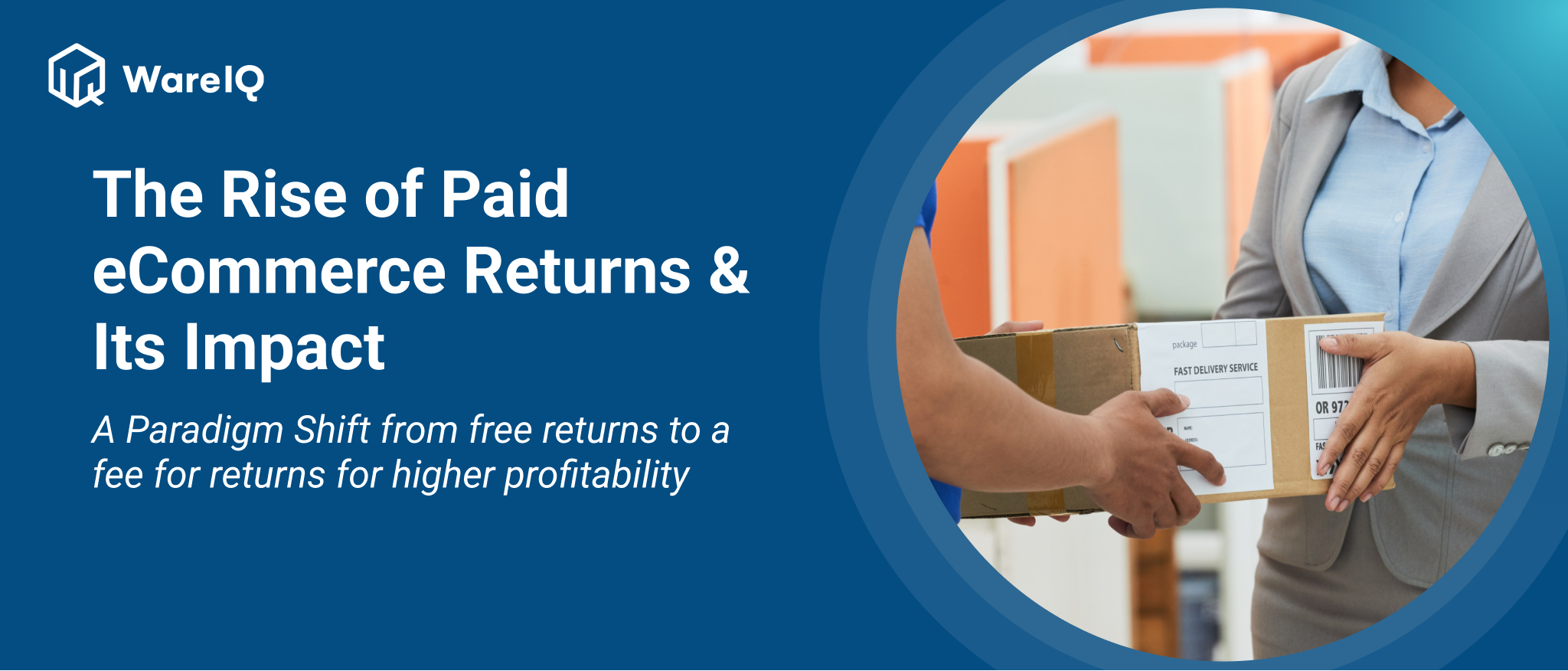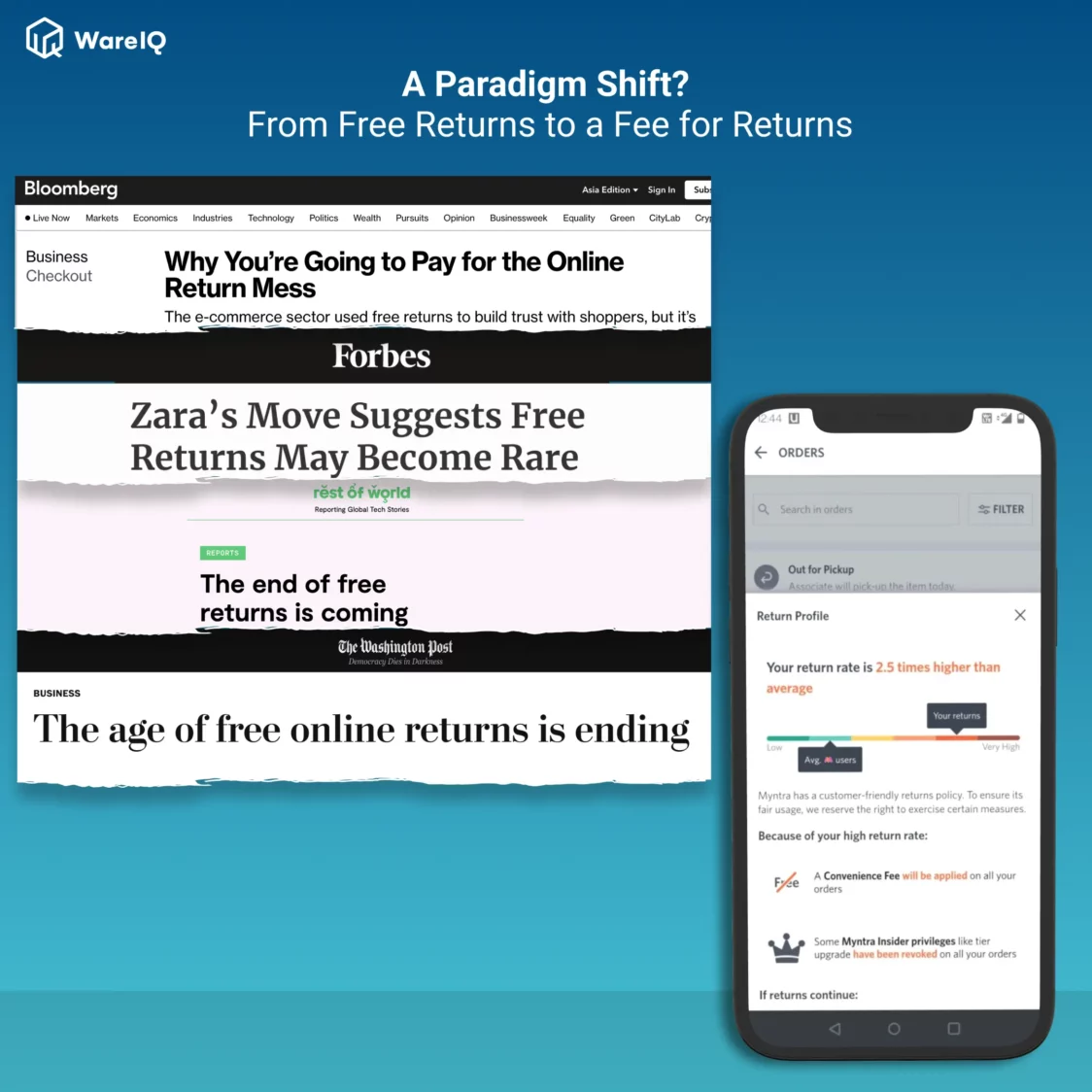
A Paradigm Shift? From Free Returns to a Fee for Returns
In recent years, there has been a noticeable shift among eCommerce brands towards charging a fee for returns. While many companies still offer free returns, an increasing number of brands are implementing policies that require customers to pay a fee when returning items. This change has been driven by a variety of factors, including rising costs associated with processing returns, the need to deter fraudulent or excessive returns, and the desire to offset the cost of offering free shipping to customers. This shift has been observed across a range of eCommerce sectors, including fashion, electronics, and home goods, and is likely to continue as brands seek to optimize their profitability and balance the needs of their customers.
“In India, about 25%–40% of clothes sold online are returned where a seller pays for forward & reverse logistics with no revenue capture.”
link
Why do Brands Want to Charge for Returns?
E-commerce brands may charge for returns for a variety of reasons, including:
- To cover the cost of processing and handling returns: Returns require additional labor and resources to process, such as restocking, repackaging, and shipping the item back to the warehouse. E-commerce brands may charge a fee to cover these costs.
- To deter excessive returns: Some customers may abuse the returns process by ordering items with no intention of keeping them, and then returning them after use or damage. Charging for returns can deter this behavior by making customers think twice before making a return.
- To offset the cost of free shipping: Many e-commerce brands offer free shipping to customers, but this can be costly for the company. By charging for returns, the brand can offset some of the cost of providing free shipping.
- To incentivize customers to keep their purchases: By charging for returns, e-commerce brands can incentivize customers to carefully consider their purchases before buying. This can lead to fewer returns and a more profitable business.
Paradigm Shift Ripples From West to East
Many eCommerce fashion and lifestyle brands have varying policies when it comes to returns and fees. Some of these brands may charge for returns, while others offer free returns. Here are some examples of eCommerce brands that may charge for returns.
In the United States and Canada, brands such as ASOS, Zara, H&M, Boohoo, TopShop etc. are charging a small fee for returns. The fee varies depending on the location and the type of item being returned.
Some Indian eCommerce marketplaces, particularly those that sell high-value items like electronics and appliances, such as Flipkart, Croma etc. have been charging a fee for returns for quite a while now. These fees typically cover the cost of processing and restocking returned items, as well as any associated shipping costs.
However, in recent years, many Indian fashion and lifestyle eCommerce brands have moved towards offering free returns as a way to attract and retain customers. This trend has been driven by intense competition in the eCommerce market, as well as rising customer expectations for convenience and flexibility.
Recently a news article from The Rest of the World publication revealed how Myntra, the leading fashion and lifestyle marketplace in India, has devised a system to identify and assign scores to customers basis the frequency of their returns. If the score of a customer crosses a specific threshold, a fee will be applied to items they then wish to return.
That said, some Indian eCommerce brands may still charge a fee for returns in certain circumstances, such as for items that are heavily discounted or for international orders. Ultimately, the decision to charge for returns will depend on a range of factors, including the company’s business model, industry dynamics, and customer preferences. As eCommerce continues to grow and evolve in India, it is likely that the policies around returns and fees will continue to evolve as well.

Bracketing: The Main Cause Behind the Rise of Return Fee
For years now, customers have been known to employ the tactic of bracketing their online purchases. Bracketing in online purchase refers to a practice where a customer purchases multiple variations or options of a product with the intention of returning some or all of them. For example, a customer might buy a shirt in three different sizes, with the intention of returning the two that do not fit properly.
The practice of bracketing is often used by customers as a way to mitigate the uncertainty associated with online shopping, particularly when it comes to sizing and fit. By ordering multiple options, customers can try on the items in the comfort of their own homes and return those that do not fit or meet their expectations.
While bracketing can be a useful strategy for customers, it can also pose challenges for eCommerce brands. When customers order multiple variations of a product with the intention of returning some or all of them, it can create additional costs and complexity for the brand in terms of processing returns and managing inventory. As a result, some eCommerce brands have implemented policies to discourage bracketing, such as charging a fee for returns or limiting the number of items that can be purchased in a single order.
“Major international corporations such as Zara, H&M, and Uniqlo have begun to implement fees for returns in specific nations to combat the practice of “bracketing,” where customers order multiple variations of size, color, or design without intending to keep all the items.”
-Harsh Vaidya, CEO, WareIQ
link
Is Charging a Return Fee Fair?
The question of whether charging a return fee for online orders is fair is a complex one and depends on various factors, including the reason for the return, the cost of processing the return, and the overall value proposition offered by the eCommerce brand.
On one hand, it can be argued that charging a return fee is fair because it allows eCommerce brands to recover some of the costs associated with processing returns, such as shipping, restocking, and quality control. If a customer is returning an item simply because they changed their mind or made an incorrect purchase, it could be argued that it is reasonable for them to cover some of these costs.
On the other hand, it can also be argued that charging a return fee can discourage customers from making purchases in the first place or returning items that they are genuinely dissatisfied with. This can ultimately hurt the customer experience and damage the reputation of the eCommerce brand.
“Any time you take away something from consumers or make them pay for something that used to be free, you’re gonna get some outcry over it.”
Sky Canaves, senior analyst of retail and e-commerce at Insider Intelligence
link

The Future of Paid Returns
On one hand, there are indications that eCommerce brands may continue to move away from charging fees for returns in order to remain competitive and meet customer expectations. As online shopping continues to grow in popularity, customers are becoming more accustomed to the convenience and flexibility of free returns and may be less willing to shop with brands that charge fees.
At the same time, there are also factors that could lead eCommerce brands to continue or even increase their use of return fees. For example, rising costs associated with processing returns, particularly for large or heavy items, could make it more difficult for eCommerce brands to offer free returns on all products. In addition, the increasing prevalence of bracketing, where customers order multiple variations of a product with the intention of returning some or all of them, could create additional costs for eCommerce brands and incentivize them to implement fees to discourage the practice.
Ultimately, the future of charging fees for returns in eCommerce is likely to be shaped by a complex interplay of factors and will depend on the strategies and priorities of individual brands and retailers.
“From my perspective, the flat fee for returns is unjust to those customers who experience actual problems, such as incorrect size, subpar fabric quality, etc. Charging a returns fee to this base could have a negative impact on their eCommerce behavior.”
-Harsh Vaidya, CEO, WareIQ
link







